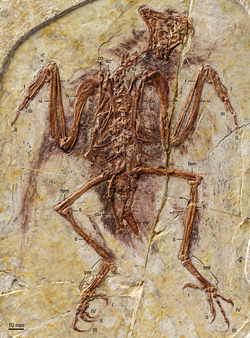Enantiornithe
| Enantiornitheans Temporal range: Early Cretaceous–Late Cretaceous, 130.7–66.0 Ma |
|
|---|---|
 |
|
| Fossil specimen of a bohaiornithid (Zhouornis hani) | |
| Scientific classification | |
| Kingdom: | Animalia |
| Phylum: | Chordata |
| Clade: | Ornithothoraces |
| Clade: |
†Enantiornithes Walker, 1981 |
| Subgroups | |
|
and see text |
|
and see text
Enantiornithes is a group of extinct avialans ("birds" in the broad sense), the most abundant and diverse group known from the Mesozoic era. Almost all retained teeth and clawed fingers on each wing, but otherwise looked much like modern birds externally. Over 80 species of enantiornitheans have been named, but some names represent only single bones, so it is likely that not all are valid. Enantiornitheans became extinct at the Cretaceous–Paleogene boundary, along with hesperornithids and all other non-avian dinosaurs. Enantiornitheans are thought to have left no living descendants.
The first enantiornitheans to be discovered were incorrectly referred to modern bird groups. For example, the first known enantiornithean, Gobipteryx minuta, was originally considered a paleognath related to ostriches and tinamou. Enantiornitheans were first recognized as a distinct lineage, or "subclass" of birds, by Cyril A. Walker in 1981. Walker made this discovery based on some partial remains from the late Cretaceous period of what is now Argentina, which he assigned to a new genus, Enantiornis, giving the entire group its name. Since the 1990s, many more complete enantiornitheans were discovered, and it was determined that a few previously described "birds" (e.g. Iberomesornis, Cathayornis, and Sinornis) were also enantiornitheans.
The name "Enantiornithes" means "opposite birds", from Ancient Greek enantios (ἐνάντιος) "opposite" + ornithes (όρνιθες) "birds" . The name was coined by Cyril Alexander Walker in his landmark paper which established the group. In his paper, Walker explained what he meant by "opposite":
...
Wikipedia
